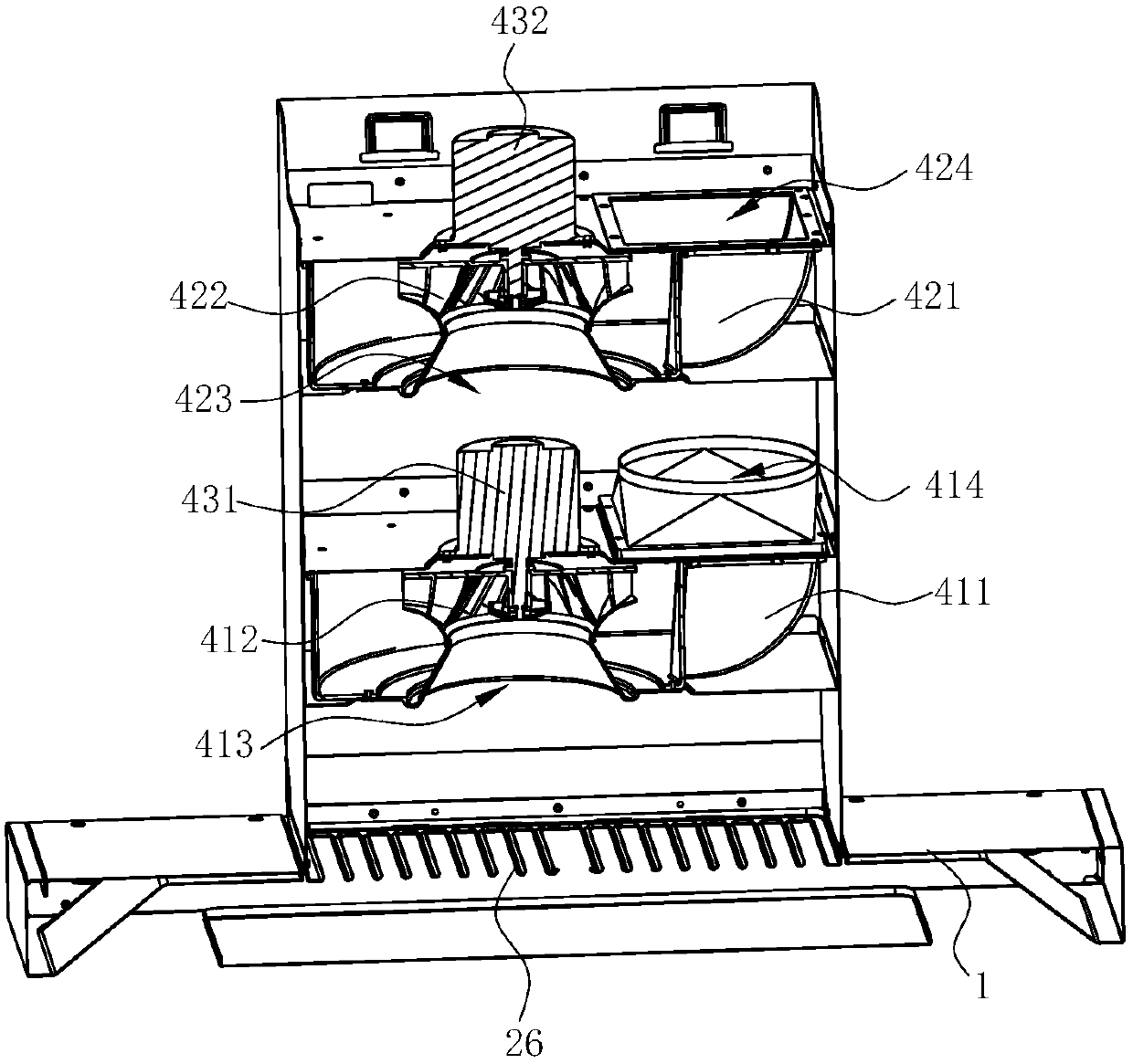Fan system and range hood using same
A technology for a fan system and a range hood, which is applied in the field of kitchen appliances, can solve the problems that the height of the cabinet exceeds the floor limit, cannot be used normally, and the volume of the centrifugal fan is large, and achieves the effect of small size, small size, and compact fan structure.
- Summary
- Abstract
- Description
- Claims
- Application Information
AI Technical Summary
Problems solved by technology
Method used
Image
Examples
Embodiment 1
[0030] See Figure 1 ~ Figure 3 , A range hood, comprising a smoke collecting hood 1, a chassis 2 located above the smoke collecting hood 1. For ease of description, in the following, "front", "rear", "left", "right", "up", "Down" refers to the position of the range hood relative to the user when the user uses the range hood, and does not limit the structure.
[0031] In this embodiment, the chassis 2 includes a front side wall 21, a left side wall 22 and a right side wall 23 located on the left and right sides, and a rear side wall 24. The aforementioned front side wall 21, left side wall 22, and right side wall A cavity is enclosed between 23 and the rear side wall 24. The cavity is the air duct 25 in the case 2. The entrance of the air duct 25 (the bottom end of the case 2) and the air inlet (not (Shown) Correspondingly, a rectifying net 26 is provided at the entrance of the air duct 25. A fan system 4 is provided in the chassis 2 and the fan system 4 includes two independen...
Embodiment 2
[0039] See Figure 4 with Figure 5 In this embodiment, the difference from the third embodiment above is that the first ternary fan 41 (as the first-stage fan) and the second ternary fan 42 (as the second-stage fan) are arranged in a staggered manner, that is, the The first volute 411 and the second volute 412 are in opposite directions, the first air inlet 413 of the first ternary fan 41 is close to the right, and the second air inlet 423 of the second ternary fan 42 is close to the left. The second air outlet 414 of the fan 41 is close to the left, and the second air outlet 424 of the second ternary fan 42 is close to the right. At this time, the first air outlet 414 of the first ternary fan 41 and the second ternary fan 42 The second air inlet 423 corresponds or nearly corresponds in the vertical direction. The distance between the first air inlet 413 and the second air inlet 423 is the distance in the vertical direction.
Embodiment 3
[0041] See Image 6 with Figure 7 In this embodiment, the difference from the third embodiment above is that the first three-element fan 41 and the second three-element fan 42 are arranged obliquely up and down respectively, that is, the first intake of the first three-element fan 41 The air inlet 413 faces downward obliquely from the horizontal direction, and the second air inlet 423 of the second three-element fan 42 faces downward obliquely from the horizontal direction.
[0042] The first air outlet 414 of the first ternary fan 41 and the second air inlet 423 of the second ternary fan 42 are connected by a duct 46. The vertical distance between the center of the first air inlet 413 of the first ternary fan 41 and the inlet of the air duct 25 is 0.5 to 2 times the diameter of the first ternary impeller 412.
[0043] This kind of oblique series connection has a lower overall height and a higher static pressure at the outlet of the fan, which is beneficial to overcome the resista...
PUM
 Login to View More
Login to View More Abstract
Description
Claims
Application Information
 Login to View More
Login to View More - R&D
- Intellectual Property
- Life Sciences
- Materials
- Tech Scout
- Unparalleled Data Quality
- Higher Quality Content
- 60% Fewer Hallucinations
Browse by: Latest US Patents, China's latest patents, Technical Efficacy Thesaurus, Application Domain, Technology Topic, Popular Technical Reports.
© 2025 PatSnap. All rights reserved.Legal|Privacy policy|Modern Slavery Act Transparency Statement|Sitemap|About US| Contact US: help@patsnap.com



